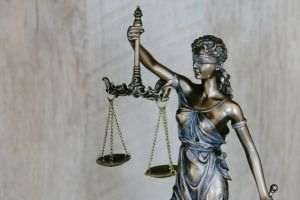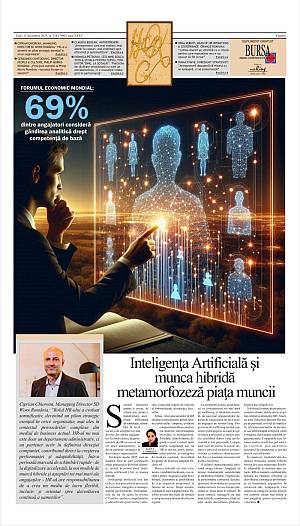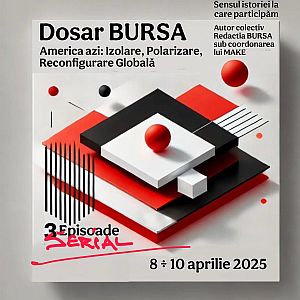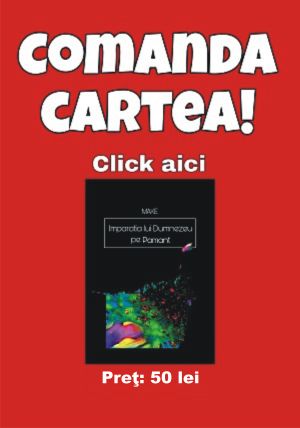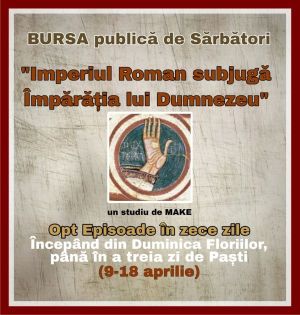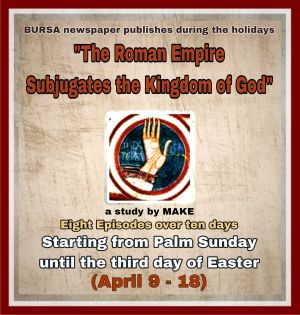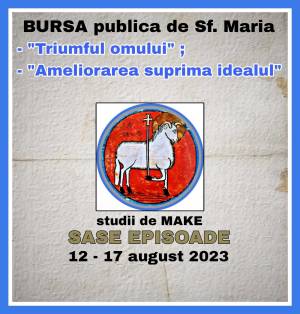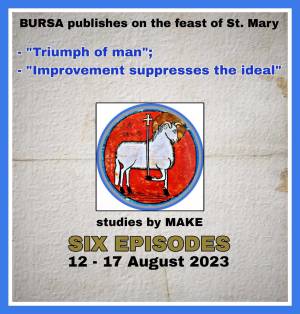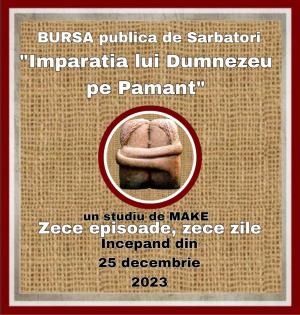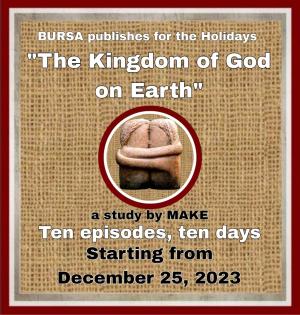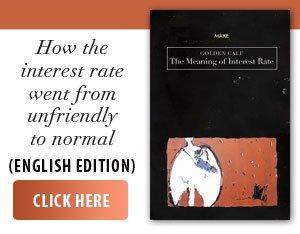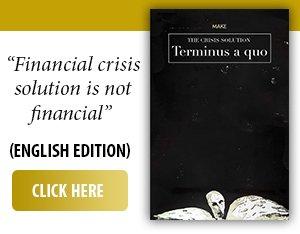
The wave effect - like circular waves of water stirred around the center where a stone has fallen - is found as an invariant in the way the Jews thought about the creation of the universe, in the way they understand the Tanakh/Old Testament around the Torah/Pentateuch, as it is described in the Torah transmission from the divine axis to the circle of the multitude (and progress in intelligibility), how the relationships between the wise men of successive rabbinic epochs are established (for example, an amora is not allowed to contradict a tanna) (1), how the relationships between the classes of norms in Halacha are established, from the divine Commandments to rabbinic rules, up to the periphery of the body of laws.
The creation of the universe is presented in Genesis as starting from Tohu wa-bohu - an indistinct desert, without qualities and without the possibility of structuring, except through divine intervention: Chapter 1 - "2. And the earth was without form, and void." ("[tohu wa-bohu] תֹ֙הוּ֙ וָבֹ֔הוּ וְחֹ֖שֶׁךְ עַל־פְּנֵ֣י תְהֹ֑ום וְר֣וּחַ אֱלֹהִ֔ים מְרַחֶ֖פֶת עַל־פְּנֵ֥י הַמָּֽיִם").
Tohu wa-bohu is the Hebrew equivalent of Chaos in Hesiod's conception of primordial matter, to which it is linked secondarily to the meaning of "astonishment" (the meanings of "gaping eyes, open mouth" are present in the Greek root of the word "chaos"), common to the two notions, as a human reaction to indistinctness.
The distinction lies in the fact that Hesiod conceives Chaos as structurable primordial matter, however, through human activity, which transforms it into Cosmos; on the other hand, Tohu wa-bohu is conceived as an unstructurable void, so that the universe is the "creation ex nihilo" of God, who creates even the primordial matter.
The way in which the Bible was initially presented, as a succession of consonants, probably uninterrupted by the signs necessary for identifying words and/or sentences, supports the idea that the primordial matter had to be created first by God, so that only later could man be involved in organizing it.
The assertion that, initially, no spaces were left between the words of the Torah does not have any direct evidence, instead, historians argue that the written documents preserved from the era in which the year 1313 BCE is estimated as the year in which the Torah was handed down to Moses (or written by him) do not show this innovation of writing with pauses between words and/or sentences, but it would have appeared later.
Of course, the calculation of the date - day, month, year - of the contact on Mount Sinai, based on the indications in the sacred text, is a striking example of how Torah should not be interpreted and how even the science of history should not be written, in order to avoid the confusion of the aberrant opposition between "creationism" and "evolutionism" (theoretical propositions cannot be opposed to expressions of the sacred, because even if they use words - and possibly the same words - they have different intentions, functions and define truth differently).
The hypothesis of such a string of consonants without pauses highlights the reader's role in attributing meanings to the mass of letters, meanings that give it structure and transform it into intelligible text.
Viewed in this way, Torah results from the imprint of God's finger on stone (2), as a signature with His name (in Kabbalah, the idea is developed that Torah is His name), as a seal on the Covenant, in which we decipher the Commandments.
The set of letters of the Aramaic abjad can be seen as a systematization of the fingerprint imprinted in the World at the moment of Creation - the same imprint as on the first tablets given to Moses - illustrating the relationship between God and the Word, taken as the center of Creation.
Torah/Law, Covenant, Imprint-Name-Seal-Letters-Word and Commandments all add up as synonyms of the source that propagates concentrically in the purposes of life, as they could be experienced in faith.
The Talmudic phrase that synthesizes the transmissions of Torah from one generation to the next (in ever-widening circles - from one, Moses, to the people - and increasingly explicit, through Aaron) omits the mention of the source: God. Of course, it would have been superfluous. But if God had been explicitly named as the source, then the propagation of the "Sinai moment" would have become more evident as a ripple effect:
[God gave Moses the Torah], "Moses received the Torah at Sinai and transmitted it to Joshua, Joshua to the elders, and the elders to the prophets, and the prophets transmitted it to the Men of the Great Assembly." (Pirkei Avot 1:1);
From the divine expression through nonverbal sounds ("thunder and lightning and the sound of the trumpet"), to Moses' gentleness, to Aaron's orality, and to the explanatory character developed by the wise.
Similarly, Halacha (3) is organized in concentric circles:
The first circle is the nucleus of divine Mizvot/Commandments;
The second circle is composed of Gezeirot - the "preventive legislation" of classical rabbis, designed to prevent the violation of Commandments;
The third circle, Takkanot - "positive legislation", practices instituted by rabbis that do not (directly) rely on Commandments as such, responding to specific needs, with local and/or temporary action.
The Fourth Circle, Minhagim, refers to those Takkanot whose rationale (temporary and/or local) has disappeared, but through prolonged practice, they have become part of the regional tradition of a community, and their observance attests to belonging to the group, becoming rules whose violation is punished with the same severity as any other category of halachic norms.
The wave effect in Rabbinic thinking appears to be back and forth, as Jews, in their search for the supreme moral principle, are said to have successively summarized the 613 Commandments (a calculation made by Rabbi Simlai in the 2nd century - that is, later than the biblical writing):
at eleven, a summary attributed to King David (4);
Isaiah reduced them to six (5);
Micah reduced them to three (6);
Isaiah came again and reduced them to two (7);
Amos reduced the entire Torah to a single commandment (8).
In Matthew 22, answering a question, Jesus summarizes Scripture as follows:
"36. Teacher, which is the greatest commandment in the Law?"
He replied: "Love the Lord your God with all your heart and with all your soul and with all your mind."
This is the first and greatest commandment.
And the second is like it: "Love your neighbor as yourself."
All the Law and the Prophets hang on these two commandments."
Behind Jesus' summary is Leviticus 19:18: "[...] love your neighbor as yourself," which has been called the "Golden Rule" common to both religions; but also Hillel's "What is hateful to you, do not do to your neighbor".
However, this reduction to principles did not gain followers in Judaism, which preferred the plurality of Commandments, their lack of hierarchy, and the confusion between them (because there are some - numerous - derived from others).
The Ten Commandments, which were recited as part of the daily Jewish liturgy, were removed out of fear that people might think that they are the essence of the Torah and that nothing else is as important. Therefore, in Judaism, there is a concern that the waves stirred in the center by God may rise without reflux.
It is likely that from this point on, the renewal triggered by Jesus Christ began, in whose words a concern for the hierarchy of the Commandments can be discerned, towards their fulfillment.
Notes
(1) According to Rabbinic periodization, the Tannaim (singular tanna - "repeaters," "teachers" - Jesus would have been a tanna, an explanation for why he is called a "teacher" in the New Testament) were the rabbinic sages whose opinions are recorded in the Mishnah, between 10-220 CE. The Tannaitic period, also known as the Mishnaic period, lasted about 210 years. It followed the Zugot period ("pairs," 170 BCE - 10 CE) and was immediately followed by the Amoraim period ("interpreters," 200-500 CE), then by the Savoraim era (500-600), Geonim (589-1034), Rishonim (1034-1563), Acharonim (1563-present).
(2) "18. And he gave unto Moses, when he had made an end of communing with him upon mount Sinai, two tables of testimony, tables of stone, written with the finger of God." (Exodus: 31)
(3) Halacha - In the general sense of the word, it is the entire body of Jewish law, from scriptures to the most recent rabbinic rulings. It is a complete system of law that governs every aspect of human life. Traditionally, it has been viewed as entirely rooted in the revealed will of God but subject to continuous interpretation by Jewish jurists. (https://www.encyclopedia.com/environment/encyclopedias-almanacs-transcripts-and-maps/halakhah-structure-halakhah)
(4) Psalm 14:
"1. Lord, who shall dwell in thy tabernacle? who shall abide in thy holy hill?
He that walketh uprightly, and worketh righteousness, and speaketh the truth in his heart.
He that backbiteth not with his tongue, nor doeth evil to his neighbour, nor taketh up a reproach against his neighbour.
In whose eyes a vile person is contemned; but he honoureth them that fear the Lord. He that sweareth to his own hurt, and changeth not.
He that putteth not out his money to usury, nor taketh reward against the innocent. He that doeth these things shall never be moved."
Note:
The enumeration of the qualities that condition dwelling in the tabernacle of God reaches the number of eleven, qualities interpreted as commandments.
(5) Isaiah 33:
"15. He that walketh righteously, and speaketh uprightly; he that despiseth the gain of oppressions, that shaketh his hands from holding of bribes, that stoppeth his ears from hearing of blood, and shutteth his eyes from seeing evil;
He shall dwell on high: his place of defence shall be the munitions of rocks: bread shall be given him; his waters shall be sure."
(6) Micah 6:
"8. He hath shewed thee, O man, what is good; and what doth the Lord require of thee, but to do justly, and to love mercy, and to walk humbly with thy God?"
(7) Isaiah 45:
"18. For thus saith the Lord that created the heavens; God himself that formed the earth and made it; he hath established it, he created it not in vain, he formed it to be inhabited: I am the Lord; and there is none else.
I have not spoken in secret, in a dark place of the earth: I said not unto the seed of Jacob, Seek ye me in vain: I the Lord speak righteousness, I declare things that are right."
(8) Amos 5:
"5. Seek ye me, and ye shall live."
Disclaimer:
This essay proposes an interpretation that does not exclude established interpretations but adds to them; the criticism it develops of religious texts is nothing more than the criticism of texts; readers are warned that the author of the essay did not intend to undermine faith and is aware that this would not be a useful or achievable objective.












